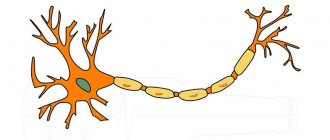The term “sensitization” is used in medicine to describe the process by which various external stimuli have an increased effect on the human body. In addition, this term is used to characterize the process of producing antibodies to infectious agents and other pathogens of various diseases. Based on these processes, desensitization programs are drawn up. Let's look at what sensitization is and consider this concept in various branches of medicine.
Sensitization of an organism in biology is an increase in its sensitivity to the effects of irritants.
Definition
The concept of sensitivity is used in psychology to describe processes that occur in the cerebral cortex and the human body when exposed to internal or external stimuli.
Psychological sensitization can explain changes in the nervous system that occur when certain factors are activated, or rather, the transformation of the system that ensures the transmission of nerve impulses and changes in the functioning of its receptors.
Academician and Nobel Prize laureate I.N. was one of the first to study sensitization. Pavlov, who was the first to note that even minimal external or internal influence increases irritation of nerve endings, spreading their activity to others responsible for receiving sensory information from the system and leading to a gradual change in their sensitivity.
The response to external stimuli is directly related to the development of habituation of the human nervous system, during which the brain develops an increased susceptibility of certain receptors to the activity of external stimuli, resulting from previously acquired experience or constant exercise.
The need for the development of sensitization arises in a person under the influence of constantly repeated actions, manifesting itself as an increase in tactile sensations in a person suffering from blindness, or developing as a result of prolonged exercise. An example of such an increase in the sensitivity of certain organs is the work of a sommelier, artist or musician.
A long-term study of the changes occurring during sensitization led to the understanding of the possibility of artificially producing the effect necessary for certain analyzers of the human body, carried out with the help of correctly selected stimulants.
Sensitization to alcohol
Alcohol is quickly absorbed and spreads throughout all organs, causing disruptions in their functioning. Alcohol is especially dangerous for the nervous system and brain. Soon after consumption, a person’s coordination is impaired, speech incoherence and other signs typical of a drunken state appear. A person who begins to drink alcohol in order to gain pleasure and achieve a certain intoxicated state, as a rule, will not give up alcohol of his own free will.
It is for such people that the method of forcibly cleansing the body of alcohol toxins and temporary relief from addiction is effective. This technique is sensitization to alcohol. Practice shows that this method of getting rid of addiction (even if temporary) is effective even for the most hardened alcoholics.
Sensitization to alcohol involves the use of certain medications, under the influence of which a stable aversion to alcohol is formed in the body. Only before using these drugs is it necessary to abstain from drinking alcohol for at least three days. The mechanism of action of sensitizing therapy is quite simple.
- after the required 3-day period of sobriety, a small capsule filled with a special long-term medication is injected under the skin layer of the patient;
- the drug does not harm the patient in any way until he drinks alcohol. Then sensitization will manifest itself in a rather pronounced form;
- the patient may not drink alcohol at all, but only inhale its vapor, which will also cause a corresponding reaction. The condition will not improve until the patient is in the fresh air;
- if the patient consumes even a small amount of a low-alcohol drink, the body will react with lightning speed to this death until the alcohol is completely removed.
Before undergoing sensitization of the body to alcohol, the patient must be warned about the consequences of drinking alcohol in the future, which is confirmed by his receipt justifying the actions of the specialists.
Reasons for appearance
Sensitization in psychology is a phenomenon whose development is directly related to the work of analyzers of the human body, which respond to the stimulating influence of external stimuli and are responsible for the appearance of a response occurring in the cerebral cortex.
Analyzers include:
- tongue, responsible for taste preferences;
- skin that reacts to temperature changes and chemical exposure;
- eyes that collect information about the color, shape and size of objects;
- a nose that reacts to the appearance of various aromas;
- internal organs (interoceptive receptors) - reflecting the processes occurring in them;
- muscles and tendons - providing information about movement;
- the vestibular apparatus, which responds to changes in body position in space.
The functions of analyzers are to initially collect information, separate it into external signals and transmit it to the brain for further study. The receptor boundaries of each analyzer are strictly individual.
Over time and when life situations change (loss of any part of the body, hearing, vision), the analyzing organs launch compensatory functions that make it possible to replace the lost information collection system with another. This phenomenon can be observed in blind people, whose body compensates for the lack of vision with excellent hearing.
Under the influence of constant external influence on any analyzer of the human body, the sensitivity of some receptors increases, followed by a decrease (desensitization) of others.
Hypersensitivity may occur when:
| Pharmacological effects | It occurs due to the reaction of receptors to the action of sensitizing medications, provoking the appearance of special susceptibility or the absence of such, for example, to adrenaline and phenamine. |
| System interaction of analyzers | It is accompanied by the simultaneous action of two or more stimuli that enhance each other’s action, which, by increasing a person’s sensitivity in one area, increases the intensity of another psychological reaction. |
| Psychological attitude | A person’s pathological fear of a certain event and its anticipation is accompanied by an increase in pain. The effectiveness of this process is due to the appearance of increased anxiety that accompanies a long, often unpleasant wait. |
| Previous experience | Constant irritation of a certain sensory system leads to the development of its special sensitivity. Thus, an artist who is constantly engaged in creativity begins to better distinguish colors and their shades over time. Most often, such sensitization becomes the result of prolonged work or constantly repeated certain exercises. |
The process of sensitization of some receptors is closely related to the desensitization of others, which arise as compensation for increasing the sensitivity necessary for a person. So, a compensatory decrease in vision may be a response of the nervous system to an increase in auditory sensitivity that occurs under the influence of strong sounds.
Kinds
Sensitization in psychology is a change in the sensitivity (sensitivity) of one of the receptors that occurs under the influence of external irritating factors.
In psychology and anatomy there are:
- Active sensitization that occurs when an allergen enters the body directly. This condition develops within 1-3 weeks from the moment of exposure to the irritant.
- Passive, occurring when a weakened allergen or vaccine is administered. This condition develops within a day and lasts about 40 weeks.
In psychological practices, sensitization occurs:
- Long-term, occurring during prolonged exposure to serious external or internal factors on the human brain. This condition most often reaches its maximum development at the age of 25-35 years, and is then accompanied by a gradual decline.
- Short-term, occurring for a short period under the influence of a sudden situation. Quite often, short-term sensitivity is caused by medications or stress.
Sensitization of relationships
In psychological practice, in contrast to anatomy, genetics and medical practice, the term sensitization is directly related to feelings and human sensations arising under the influence of external stimuli acting on brain receptors.
A change in sensitivity in this case most often occurs under the influence of:
- age-related changes and reach maximum concentration by the age of 20-30;
- endocrine imbalance associated with severe stress and nervous breakdowns;
- psychiatric disorders.
The appearance of increased sensitivity of sensations can also occur as a result of overwork.
The occurrence of a strong external stimulus triggers an instantly spreading reaction in the human brain, causing an increased concentration of attention to one adapter, with a corresponding decrease in sensitivity to others.
A contrast of sensations invariably occurs when several stimuli are simultaneously exposed, which makes it possible to enhance the effect of adapters operating in series.
Under the influence of the sensations that arise during short-term sensitization, a light object drawn on a dark background will seem even lighter, and when a hot hand touches a cold object, it will seem that it is also hot. Based on such close interaction in psychology, methods of treatment for alcoholism have been developed.
Sensitization of sensations also directly depends on a person’s age, since due to an unstable psychological system, the baby cannot fully respond to changes in sensitivity.
Enhanced sensations
Scientists have proven that increased sensations occur against the background of:
- Age-related changes.
- Disturbances of the endocrine balance of the body. Under severe stress, nervous breakdowns, and pregnancy, the perception of habitual stimuli changes.
- Pathologies of the nervous system. People with mental disorders and disorders of the nervous system are more susceptible to sensitization.
With overwork and lack of sleep, temporary sensitization occurs.
Attention should also be paid to the contrast of sensations - changes in the quality and intensity of sensations under the influence of accompanying, preliminary stimuli.
When a person is exposed to two irritating factors at once, a simultaneous contrast appears.
For example, against a white background, a dark object will appear lighter, and against a dark background, a white object will appear darker.
The consistent contrast can be traced by a simple example - if you touch a weakly heated object with a cold hand, you will feel that it is hot.
Sensitization of the senses in children
Sensitization in children is an increase in the activity of the child’s body to repeated exposure to certain stimuli. As a result of such activity, the child’s sensitivity increases, forcing the baby to perform the required sequence of actions.
A similar degree of expression of feelings is typical for children who have reached the age of 4-5 years, since in infants the analyzer system works only on external reflection.
A person’s sensations reach their greatest intensity from the age of 25-35, and then gradually decrease.
The sensory organization of the human body is not stable, easily changing under the influence of external and internal factors. The personality of a child or adult is considered fully formed even with limited sensory perception, which allows, due to compensatory mechanisms, to replace the lost analyzer with increased sensitivity of other receptors.
Psychotherapy for sensitization
Of great importance for the effectiveness of sensitization is the patient’s attitude and his desire to recover from addiction. Therefore, psychotherapy is a mandatory element of treating alcoholism in this way. Its main goals are:
- recognition by alcohol addicts of having serious problems with alcohol;
- understanding and acceptance by the alcoholic of the fact that he cannot get rid of it on his own.
It is especially important that the patient himself understands the need for such treatment. During periods of forced abstinence from drinking alcohol, patients especially need psychological support. Particularly high rates of psychotherapy are observed in the treatment of patients with the first and second stages of addiction; a much smaller effect is present in alcoholics with the third stage of the disease. The latter are often recommended for group classes.
Typically, psychotherapeutic work begins even before sensitizing therapy, so that the alcohol addict receives an orientation towards the need to recover from addiction. At the end of sensitization, it is also advisable to undergo a course of psychotherapy in order to consolidate the formed aversion to alcohol and avoid relapses in the future. As a result, patients acquire a strong desire to improve their lives and overcome addiction, and the results of treatment are consolidated at the level of reflexes - the patient develops a persistent aversion to any type of drinking.
Sensitization and synesthesia
Increased sensitivity is closely related to joint sensations (synesthesia), which is responsible for the ability of a stimulus in one organ to cause similar feelings in other parts of the body. The most striking example is the appearance of a salty taste in the mouth at the sight of salt, or the feeling of acidity at the sight of a lemon.
This also includes the appearance of colored visual images that arise while reading or listening to musical works. The explanation of this psychological phenomenon is due to the fact that when one adapter is excited, a synthetic transfer of sensitivity (sensitivity) occurs to others, causing similar symptoms in them.
Adaptation
Sensitization in psychology is a process that precedes adaptation, characterized by the gradual adaptation of the nervous system to external influences, accompanied by an increase in perception of previously unnoticed little things.
Under the influence of constantly acting external factors, irritation of certain adapters is transformed:
- in dulling of the senses, which occurs under the influence of irritating factors and appears, for example, when a person spends a long time in a perfume store;
- into anesthesia, accompanied by a complete loss of sensitivity to the previously disturbing stimulus.
The development of adaptation significantly increases a certain threshold of sensitivity and makes it possible to distinguish previously elusive nuances, which, in particular, is used by perfume creators when composing a new fragrance.
Cumulation and addiction under the influence of harmful substances
⇐ PreviousPage 12 of 14Next ⇒
Cumulation - “accumulation”:
1. Material cumulation - the gradual accumulation of a mass of poison in
2. Functional cumulation - accumulation of changes caused by poison in the body.
They often coexist simultaneously (both the mass of the poison and its effects increase) but can be separate. So, many vapors and gases (gasoline, benzene, chlorinated hydrocarbons) are constantly released when inhaled, that is, there is no accumulation, but the effects grow - this is only a functional cumulation >
chronic poisoning. Only material cumulation is common in chronic metal poisoning. The faster the harmful effects of a substance that regularly enters the body accumulate, the greater the risk of chronic poisoning. Therefore, the degree of cumulative properties affects its hygienic regulation: the higher its cumulative properties, the lower the MPC should be.
Cumulation coefficient
Used to assess the cumulative properties of industrial poisons.
where DL50 is for chronic administration, DL50 is for single administration.
First, the DL50 of the substance is determined (10 mg/kg). Then they begin to produce seeds in doses of 1/10; 1/20 and 1/50 DL50 daily on weekdays. Sooner or later, 50% of the animals will die, calculate the dose they received - this will be XDL50.
Cumulative action classification
| Danger level | TO. |
| I. Overcumulation II. Pronounced cumulation III. Average cumulation IV. Weak cumulation | <1 1 — 2,2 2,2 – 5 >5 |
Getting used to poisons
The body has the property of adaptability - that is, the ability to adapt to changing environmental conditions by changing life processes.
Adaptation is a process that occurs under the influence of any qualitatively or quantitatively unusual factor. Adaptation can take fractions of a second (light - pupil), months (physical activity - muscle growth) and years (genetic changes - skin color, etc.).
The term “addiction” in toxicology is usually used to refer to the body’s adaptation to periodic exposure to a harmful substance. Most often this refers to a decrease in the body’s sensitivity to chemical effects, which occurs under the influence of repeated/regular exposure to poison.
Thus, addiction in toxicology is an anthropogenic factor, and adaptation is “evolutionary,” that is, as a process that appears when encountering normal, non-anthropogenic factors.
The body's response to addiction has three phases.
1) The phase of primary reactions is the period of searching for ways to adapt the body to changed environmental conditions. Characterized by: 1) increased activity of systems that carry out the biotransformation of poison; 2) increased activity of the sympathetic nervous system; 3) reducing the body’s resistance to other external influences.
2) The phase of development of addiction - externally - a phase of well-being, the body’s resistance increases (hypoxia, other harmful substances).
3) Phase of severe intoxication - adaptation mechanisms are exhausted, resistance drops sharply.
Examples:
1) When habituating to cobalt (DL50~50mg/kg) - 13x2.5mg/kg, a dose of 1000 mg/kg is needed to induce DL5o.
But - a number of metals are not addictive - copper, nickel, iron, selenium.
2) When getting used to gasoline, resistance to ethanol increases.
3) When getting used to mercury, resistance to lead and cadmium increases.
Adaptation to the action of chemicals is a true adaptation of the body to changing environmental conditions (especially chemical ones), which occurs without irreversible damage to a given biological system and without exceeding the normal (homeostatic) capabilities of its response. This adaptation is sometimes called physiological, true, or complete adaptation.
The body's adaptation to changing OS conditions may be due to changes that occur in excess of normal homeostatic capabilities. In this case, they talk about compensation (pseudo-adaptation) of the effects of substances.
Compensation is a temporarily hidden pathology, which over time can be revealed in the form of obvious pathological changes (decompensation). Thus, with compensation, the organism's adaptation to the environment is achieved through disruption of homeostasis.
The term “addiction” is also used in the literature, which is understood as a decrease or disappearance of the reaction to the influence of a substance after a certain period of its action. The toxicological effect occurs again with increasing dose (concentration) of the active substance. Habituation can be associated with various mechanisms, but, as a rule, it is a stage of chronic recovery. Let us note that addiction to poisons with specific effects develops with great difficulty compared to non-specific poisons.
Habituation also depends on the mode of exposure to the substance; sharply and randomly fluctuating concentrations make it difficult to develop compensatory reactions (Fig. 6).
In some cases, for example, with an allergic effect, there is an increase in the body’s sensitivity to the effects of the substance. This phenomenon is called sensitization. Sometimes medications have a sensitizing effect, especially antibiotics, pesticides and other substances used in agriculture.
⇐ Previous12Next ⇒
Recommended pages:
Sensitization theory
Sensitization in psychology is a phenomenon described by Nobel Prize laureate I.N. Pavlov, who found out in the course of his work that repeated exposure to the same stimulus invariably leads to a decrease in the sensitivity threshold.
Constant exposure to the same receptors allows excitation to spread to other areas of the cerebral cortex. This process provokes the work of other analyzers, which leads to their wear and gradual modification.
The principle of modification studied by the physiologist subsequently became the basis for the method of combating alcohol and drug addiction.
According to Academician Pavlov, even a small irritating effect increases the excitation of the nervous system, which affects the functioning of all organs and receptors. The resulting excitation becomes the basis for the appearance of a constant concentration, which causes a decrease in the sensitivity of other receptors.
The theory developed by Ivan Petrovich became the basis for the creation of a technique that allows, with the help of pharmaceuticals, to cause a person’s persistent aversion to alcohol.
The action of products that create a barrier to the entry of harmful substances provokes a gradual cessation of alcoholic beverages, ending with the patient receiving a kind of pleasure from giving up alcohol.
What is sensitization
Sensitization in medicine is a process as a result of which the human body actively reproduces antibodies that are used to protect against pathogens of various diseases. The foundation of various desensitization techniques is built on the principles of this process. The desensitization program is based on reducing the influence of provoking factors, which eliminates the body's susceptibility to pathogens. Upon re-entry into the body, the immune system triggers the synthesis of antibodies that destroy harmful microorganisms.
The sensitizing effect is an extraordinary training of the human body, which makes it possible to reduce the influence of aggressive factors. This action is based on the adaptation of internal systems to the negative effects of stimuli in order to prevent their damage.
Sensitization is one of the important components of such a branch of medicine as immunology. As an example, let us consider a situation in which an infectious agent enters the human body. Infection with a virus allows the immune system to trigger the creation of antibodies to destroy harmful microorganisms. The creation of these antibodies allows the immune system to prevent relapse of the disease and counteract the re-entry of bacteria and viruses. Thus, human immunity protects internal systems from dangerous consequences that could cause death.
The term “sensitization” is mentioned quite often in allergology. It is used to describe the development and manifestation of different types of allergic reaction . Household sensitization is the effect of “household” allergens on the human body, which leads to the appearance of allergy symptoms . Based on sensitization, specialists use various methods that help identify the degree of sensitivity to various allergy triggers.
Also, the term “sensitization” is actively used in the field of psychology to explain the phenomenon of increased sensitivity of the nervous system to the effects of various stimuli. According to experts, sensitization of the body has a close relationship with the processes of sensory adaptation. It is important to note that the phenomenon in question is observed in all living organisms . The only difference is the intensity of this process. At its core, sensitization is an increase in the degree of sensitivity, which is the result of exposure to systematic exercises or the actions of various analyzers. Thus, sensitization of the body can be identified through special training.
The process of sensitization makes the body very susceptible to specific substances
According to experts, there are two areas that have an impact on the sensitivity of analyzers. The first group includes various pathologies that disrupt the functioning of sensory analyzers. Such pathologies include blindness. In this example, sensitization of the body is caused by the need to carry out compensatory actions. The second group includes various actions that increase the sensitivity of the analyzers. In this case, importance is given to the specific requirements of various types of activities.
Management techniques, can you develop them in yourself?
Sensitization in psychology is a mental phenomenon that explains the increase in the sensitivity of some nerve receptors, while simultaneously affecting another analytical organ. Increased sensitivity can occur not only under the influence of external influences, but also in the process of constant training, as well as spontaneously.
Spontaneous sensitization occurs when it is necessary to compensate for sensory defects. Loss of vision or hearing leads to high tactile and vibration sensitivity. Thus, completely deaf people are able to hold their hand at the throat of their interlocutor to determine the essence of the conversation, and also feel the melody by the vibration of a musical instrument.
Sensitization caused by professional activity develops in people due to their professional activity, which forces them to constantly influence the necessary adapters.
The processual development of increased sensitivity with constant training occurs:
- jewelers who are unable to work without visual acuity;
- for tasters who use taste buds in their work;
- perfumers who can distinguish any odors;
- in musicians who hear halftones of sounds;
- among artists who have trained their visual organs to distinguish color shades invisible to the average person.
Despite the large number of factors, specific exercises for development have not been fully studied. There is no specific algorithm of actions for managing sensitization, since the structure of human receptors is quite plastic and easily adapts to any life situation.
For example, in a blind person, the number of tactile receptors on the fingertips is 1.5 times greater than the number of receptors in a sighted person. In psychological practice, the sensitization technique is used to identify a person’s phobias and help combat them.
So, during a psychological session, a specialist:
- at the first stage, establishes trusting contact with the client;
- at the second stage, the specialist forces the patient to create the most terrible situation in his mind and mentally imagine the panic that gripped him. Next, the client actually immerses himself in the situation he has created and discovers that the fears that previously tormented him are, in fact, not at all dangerous.
Under the influence of sensitization during the session, a stressful situation is created, comparable to teaching a child to swim, to the moment when he is thrown into the water in the deepest part of the lake.
Preparations for sensitization
Sensitizing therapy is based on the use of not only subcutaneous capsules; drugs of various forms can be used - tablets, intramuscular or subcutaneous injections, etc. The list of medications is quite extensive, which allows you to select the optimal treatment option for each patient. Among the most well-known and preferred sensitizing drugs, the following stand out:
- Disulfiram;
- Antabuse;
- Tetradin;
- Esperal;
- Lidevin;
- Stopped;
- Contrapot;
- Espenal, etc.
Each of the above medications is absolutely harmless to the body, but only until ethanol penetrates it. Even very small doses of alcohol (for example, contained in medicinal alcohol tinctures) upon penetration into a sensitized body cause an immediate reaction, which can lead to very dangerous consequences such as coma and even death. Therefore, self-medication with sensitizing agents is strictly prohibited.
The most popular drugs used in sensitizing therapy today are those based on the substance disulfiram. The therapeutic sensitizing properties of nicotinic acid are being actively studied. Its effectiveness is comparable to disulfiram, but at the same time, nicotinic acid is vitamin B₃ or PP, so the treatment will be more gentle.
Using sensitization in everyday life
Sensitization techniques are widely used not only in psychology and medicine, but also in everyday life:
- When composing commercials, marketers specially add bright colors and shapes to them, which activate the visual organs and force them to create various, bright pictures in the brain.
- Designers try to combine colors when decorating the interior.
- The increased sound that accompanies commercials makes the memory absorb information faster.
- Elements of different colored shapes in construction make it possible to emphasize the horizontal and vertical position of the building.
- Company employees try to stimulate the client to make a purchase with small gifts.
- Medical professionals use drugs that cause discomfort in the human body to “code” patients against alcoholism.
- Colorful advertising posters with voluminous bright drawings accompany discounts and other store promotions.
Sensitization in psychology is an increase in certain feelings that occurs under the influence of external stimuli acting on the organs of hearing, vision and movement. The irritation that occurs during exposure directly depends on age, state of health, psychological mood and use of drugs.
Sensitivity to external stimulation of one of the adapters, which changes throughout life, stimulates the work of the entire cerebral cortex, allowing a person to compensate with new abilities for previously lost functions or, with constant training, to develop increased perception necessary for certain types of activities.
Types of allergic reactions
The mechanism of occurrence of all allergic reactions is the same, but clinical manifestations can be completely different. Depending on the type of response of the body, they are divided into:
- 1. Anaphylactic (immediate type). They are characterized by a rapid course due to the release of large amounts of histamine, which has a strong effect on organs and tissues. The reaction time after contact with an allergen is from 2-5 minutes to several hours. Type of development: anaphylactic shock, urticaria, atopic bronchial asthma, allergic rhinitis, Quincke's edema, acute food intolerance, various allergic reactions in children.
- 2. Cytoxic. Characterized by the destruction and death of body cells. They occur more slowly, with full manifestation occurring within a few hours. Type of manifestation: hemolytic anemia and hepatitis of newborns caused by Rh conflict, thrombocytopenia, complications after blood transfusion, drug allergies.
- 3. Immunocomplex. Characterized by damage to the internal walls of the capillaries. They appear within a few hours or days. These include allergic conjunctivitis and dermatitis, serum sickness, rheumatoid arthritis, glomerulonephritis, systemic lupus erythematosus, hemorrhagic vasculitis.
- 4. Late hypersensitization. Characterized by the release of lymphokines that cause inflammatory reactions. Manifestation - a day or more after contact with the allergen. These are diseases such as contact dermatitis, bronchial asthma, rhinitis.
- 5. Stimulating hypersensitivity reactions. They are characterized by the process of replacing hormones with antibodies, resulting in stimulation or inhibition of organ activity. Examples of diseases: diffuse toxic goiter, insulin-resistant diabetes, some types of myasthenia gravis, anemia, gastritis.
Allergies can be of two types:
- 1. Polyvalent. It implies sensitivity to several allergens of the same or different groups. As an immune response, a whole complex of substances characteristic of different types of allergies is produced, so the symptoms of manifestation are significantly expanded.
- 2. Cross allergy is due to the similarity of the chemical structure of some substances, namely a set of amino acids. An allergic reaction to one irritant can also trigger a substance of similar structure. For example, sensitization to cow's milk protein can provoke a similar reaction to beef or the milk of other animals.










